Alessio Micheli
Addressing the Scarcity of Benchmarks for Graph XAI
May 18, 2025Abstract:While Graph Neural Networks (GNNs) have become the de facto model for learning from structured data, their decisional process remains opaque to the end user, undermining their deployment in safety-critical applications. In the case of graph classification, Explainable Artificial Intelligence (XAI) techniques address this major issue by identifying sub-graph motifs that explain predictions. However, advancements in this field are hindered by a chronic scarcity of benchmark datasets with known ground-truth motifs to assess the explanations' quality. Current graph XAI benchmarks are limited to synthetic data or a handful of real-world tasks hand-curated by domain experts. In this paper, we propose a general method to automate the construction of XAI benchmarks for graph classification from real-world datasets. We provide both 15 ready-made benchmarks, as well as the code to generate more than 2000 additional XAI benchmarks with our method. As a use case, we employ our benchmarks to assess the effectiveness of some popular graph explainers.
Learning to quantify graph nodes
Mar 19, 2025

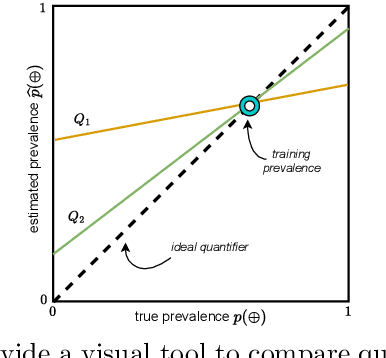

Abstract:Network Quantification is the problem of estimating the class proportions in unlabeled subsets of graph nodes. When prior probability shift is at play, this task cannot be effectively addressed by first classifying the nodes and then counting the class predictions. In addition, unlike non-relational quantification on i.i.d. datapoints, Network Quantification demands enhanced flexibility to capture a broad range of connectivity patterns, resilience to the challenge of heterophily, and efficiency to scale to larger networks. To meet these stringent requirements we introduce XNQ, a novel method that synergizes the flexibility and efficiency of the unsupervised node embeddings computed by randomized recursive Graph Neural Networks, with an Expectation-Maximization algorithm that provides a robust quantification-aware adjustment to the output probabilities of a calibrated node classifier. We validate the design choices underpinning our method through comprehensive ablation experiments. In an extensive evaluation, we find that our approach consistently and significantly improves on the best Network Quantification methods to date, thereby setting the new state of the art for this challenging task. Simultaneously, it provides a training speed-up of up to 10x-100x over other graph learning based methods.
Modeling Edge Features with Deep Bayesian Graph Networks
Aug 17, 2023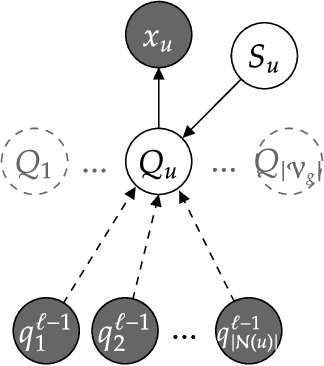
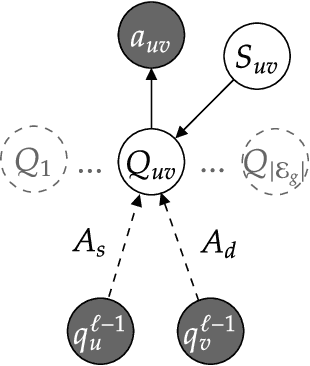
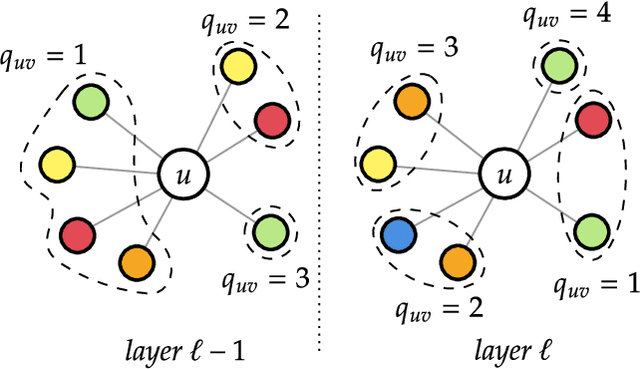
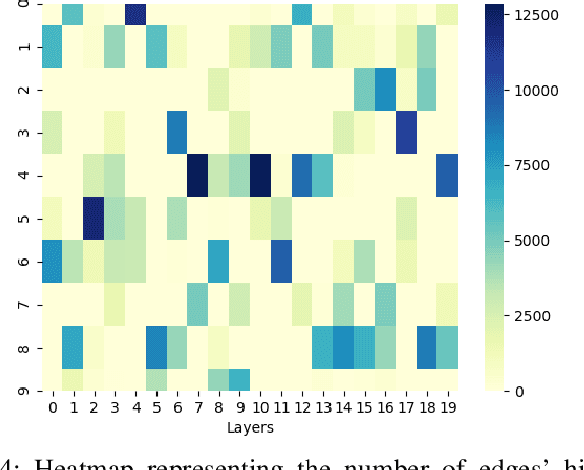
Abstract:We propose an extension of the Contextual Graph Markov Model, a deep and probabilistic machine learning model for graphs, to model the distribution of edge features. Our approach is architectural, as we introduce an additional Bayesian network mapping edge features into discrete states to be used by the original model. In doing so, we are also able to build richer graph representations even in the absence of edge features, which is confirmed by the performance improvements on standard graph classification benchmarks. Moreover, we successfully test our proposal in a graph regression scenario where edge features are of fundamental importance, and we show that the learned edge representation provides substantial performance improvements against the original model on three link prediction tasks. By keeping the computational complexity linear in the number of edges, the proposed model is amenable to large-scale graph processing.
Is Rewiring Actually Helpful in Graph Neural Networks?
May 31, 2023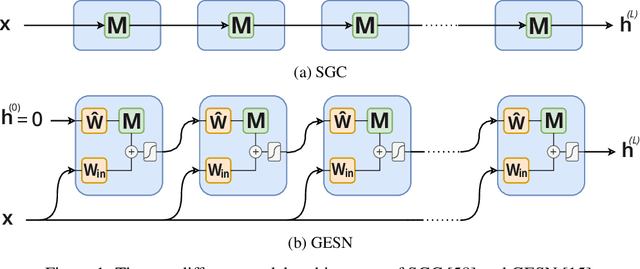
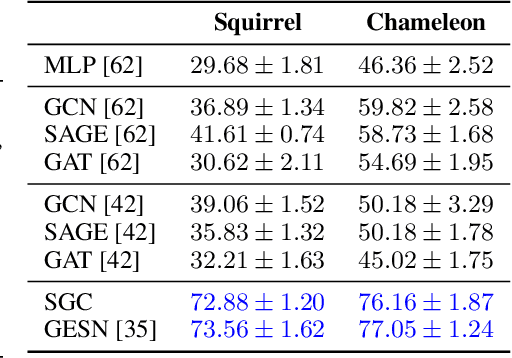
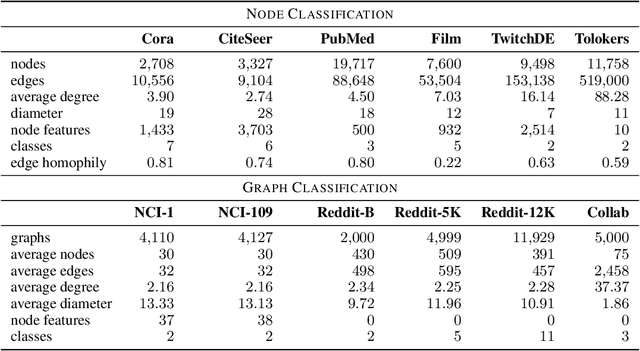
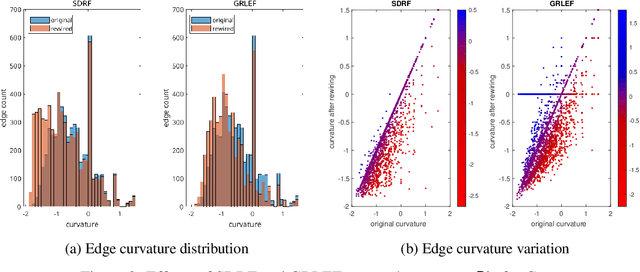
Abstract:Graph neural networks compute node representations by performing multiple message-passing steps that consist in local aggregations of node features. Having deep models that can leverage longer-range interactions between nodes is hindered by the issues of over-smoothing and over-squashing. In particular, the latter is attributed to the graph topology which guides the message-passing, causing a node representation to become insensitive to information contained at distant nodes. Many graph rewiring methods have been proposed to remedy or mitigate this problem. However, properly evaluating the benefits of these methods is made difficult by the coupling of over-squashing with other issues strictly related to model training, such as vanishing gradients. Therefore, we propose an evaluation setting based on message-passing models that do not require training to compute node and graph representations. We perform a systematic experimental comparison on real-world node and graph classification tasks, showing that rewiring the underlying graph rarely does confer a practical benefit for message-passing.
Addressing Heterophily in Node Classification with Graph Echo State Networks
May 14, 2023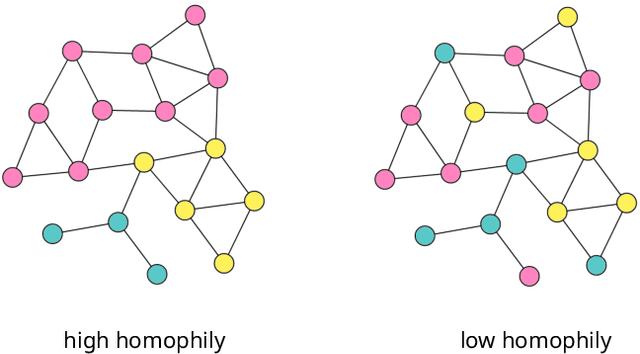
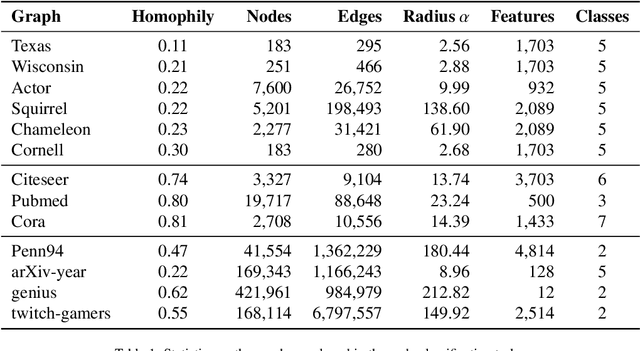

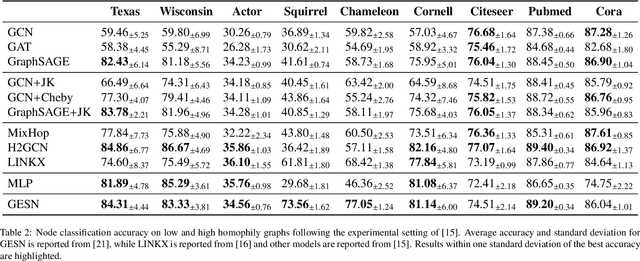
Abstract:Node classification tasks on graphs are addressed via fully-trained deep message-passing models that learn a hierarchy of node representations via multiple aggregations of a node's neighbourhood. While effective on graphs that exhibit a high ratio of intra-class edges, this approach poses challenges in the opposite case, i.e. heterophily, where nodes belonging to the same class are usually further apart. In graphs with a high degree of heterophily, the smoothed representations based on close neighbours computed by convolutional models are no longer effective. So far, architectural variations in message-passing models to reduce excessive smoothing or rewiring the input graph to improve longer-range message passing have been proposed. In this paper, we address the challenges of heterophilic graphs with Graph Echo State Network (GESN) for node classification. GESN is a reservoir computing model for graphs, where node embeddings are recursively computed by an untrained message-passing function. Our experiments show that reservoir models are able to achieve better or comparable accuracy with respect to most fully trained deep models that implement ad hoc variations in the architectural bias or perform rewiring as a preprocessing step on the input graph, with an improvement in terms of efficiency/accuracy trade-off. Furthermore, our analysis shows that GESN is able to effectively encode the structural relationships of a graph node, by showing a correlation between iterations of the recursive embedding function and the distribution of shortest paths in a graph.
Leave Graphs Alone: Addressing Over-Squashing without Rewiring
Dec 13, 2022



Abstract:Recent works have investigated the role of graph bottlenecks in preventing long-range information propagation in message-passing graph neural networks, causing the so-called `over-squashing' phenomenon. As a remedy, graph rewiring mechanisms have been proposed as preprocessing steps. Graph Echo State Networks (GESNs) are a reservoir computing model for graphs, where node embeddings are recursively computed by an untrained message-passing function. In this paper, we show that GESNs can achieve a significantly better accuracy on six heterophilic node classification tasks without altering the graph connectivity, thus suggesting a different route for addressing the over-squashing problem.
Beyond Homophily with Graph Echo State Networks
Oct 27, 2022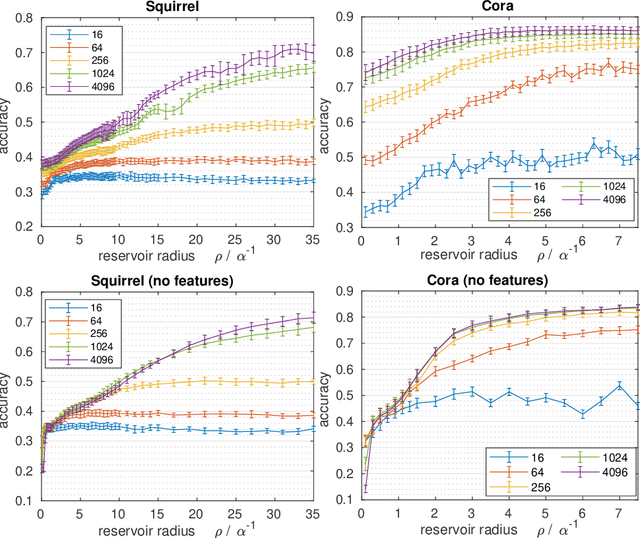
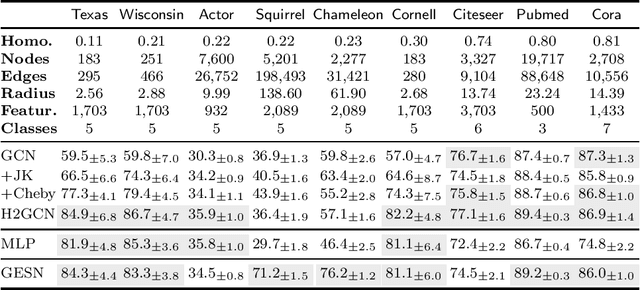
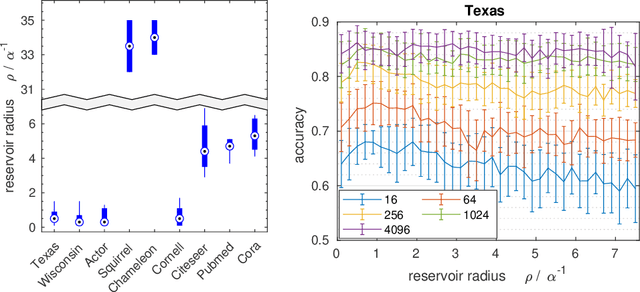
Abstract:Graph Echo State Networks (GESN) have already demonstrated their efficacy and efficiency in graph classification tasks. However, semi-supervised node classification brought out the problem of over-smoothing in end-to-end trained deep models, which causes a bias towards high homophily graphs. We evaluate for the first time GESN on node classification tasks with different degrees of homophily, analyzing also the impact of the reservoir radius. Our experiments show that reservoir models are able to achieve better or comparable accuracy with respect to fully trained deep models that implement ad hoc variations in the architectural bias, with a gain in terms of efficiency.
* Accepted for oral presentation at ESANN 2022
Dynamic Graph Echo State Networks
Oct 16, 2021

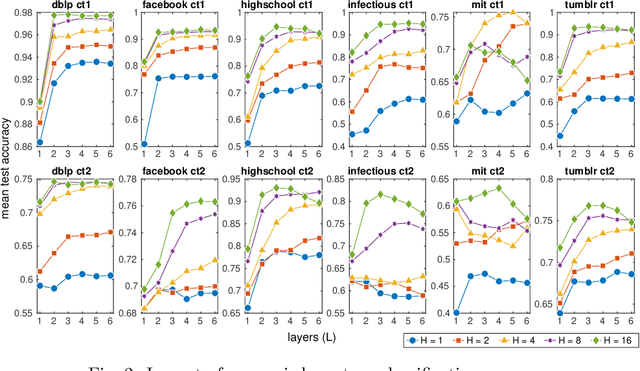

Abstract:Dynamic temporal graphs represent evolving relations between entities, e.g. interactions between social network users or infection spreading. We propose an extension of graph echo state networks for the efficient processing of dynamic temporal graphs, with a sufficient condition for their echo state property, and an experimental analysis of reservoir layout impact. Compared to temporal graph kernels that need to hold the entire history of vertex interactions, our model provides a vector encoding for the dynamic graph that is updated at each time-step without requiring training. Experiments show accuracy comparable to approximate temporal graph kernels on twelve dissemination process classification tasks.
TEACHING -- Trustworthy autonomous cyber-physical applications through human-centred intelligence
Jul 14, 2021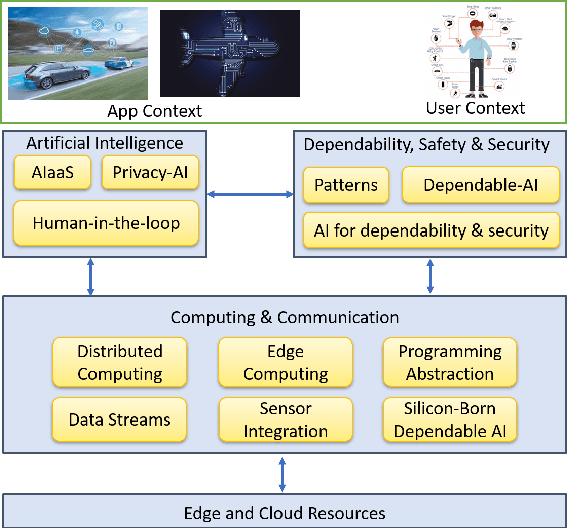
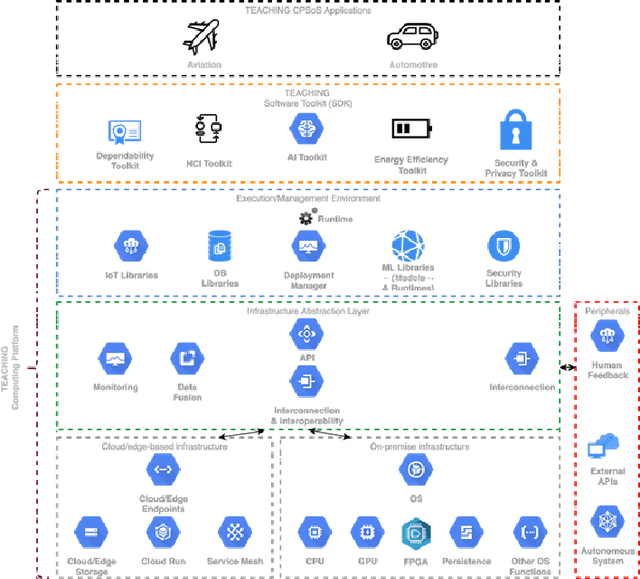
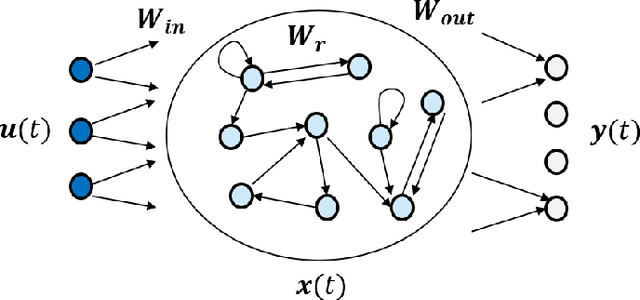
Abstract:This paper discusses the perspective of the H2020 TEACHING project on the next generation of autonomous applications running in a distributed and highly heterogeneous environment comprising both virtual and physical resources spanning the edge-cloud continuum. TEACHING puts forward a human-centred vision leveraging the physiological, emotional, and cognitive state of the users as a driver for the adaptation and optimization of the autonomous applications. It does so by building a distributed, embedded and federated learning system complemented by methods and tools to enforce its dependability, security and privacy preservation. The paper discusses the main concepts of the TEACHING approach and singles out the main AI-related research challenges associated with it. Further, we provide a discussion of the design choices for the TEACHING system to tackle the aforementioned challenges
Phase Transition Adaptation
Apr 20, 2021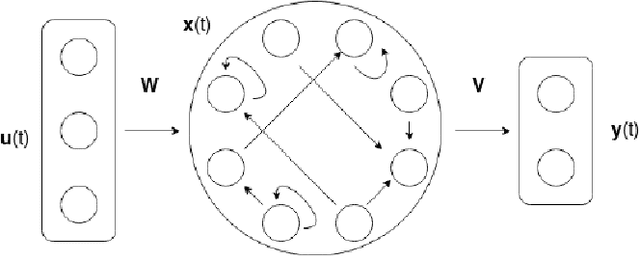
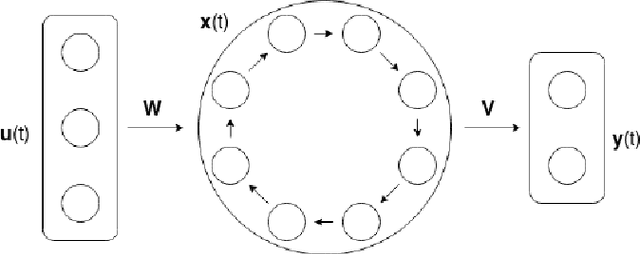
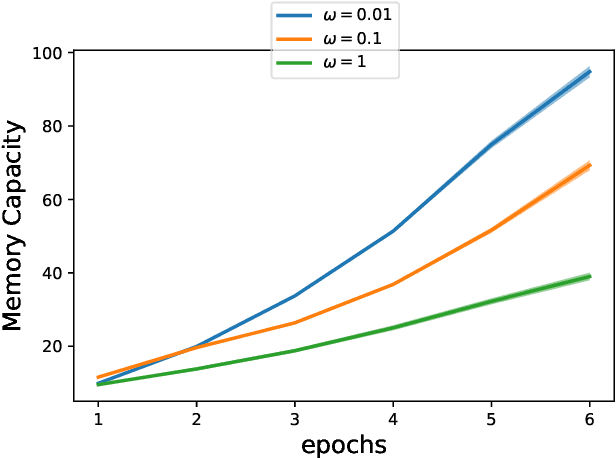

Abstract:Artificial Recurrent Neural Networks are a powerful information processing abstraction, and Reservoir Computing provides an efficient strategy to build robust implementations by projecting external inputs into high dimensional dynamical system trajectories. In this paper, we propose an extension of the original approach, a local unsupervised learning mechanism we call Phase Transition Adaptation, designed to drive the system dynamics towards the `edge of stability'. Here, the complex behavior exhibited by the system elicits an enhancement in its overall computational capacity. We show experimentally that our approach consistently achieves its purpose over several datasets.
 Add to Chrome
Add to Chrome Add to Firefox
Add to Firefox Add to Edge
Add to Edge